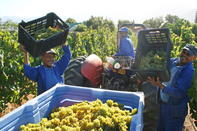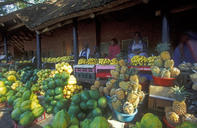Since a third of all food produced for human consumption is lost at some point between the field and the fork, the United Nations Food and Agriculture Organization (FAO) report on food waste recommends a few solutions at various points in the food value chain. ©Louise BrodieThe UN warns against the overproduction of crops, which leads to food wastage.The report suggests better coordination and communication between farmers to avoid overproduction of certain crops (crop surpluses create a glut on the market and drive down prices, thus making that year’s harvest economically unviable for the farmer, but in this context, surpluses are often diverted away from the plate and into animal feed).
©Louise BrodieThe UN warns against the overproduction of crops, which leads to food wastage.The report suggests better coordination and communication between farmers to avoid overproduction of certain crops (crop surpluses create a glut on the market and drive down prices, thus making that year’s harvest economically unviable for the farmer, but in this context, surpluses are often diverted away from the plate and into animal feed).
An effort should be made to create ‘substandard’ markets for food that does not quite fit a retailer’s shape and size standards, but where the food is still fit for human consumption. Because consumers want a wide selection of foods and the scales of economy that push down prices for them, retailers tend to overstock shelves, leading to spoilage of unsold surpluses as consumers buy the freshest foods and avoid foods closer to their sell-by dates. The report suggests improved market cooperatives and facilities as a way of dealing with this problem. ©Roger de la HarpeAn informal produce market in KwaZulu-Natal.Poorer consumers cannot afford to waste – they buy what they need and generally use it up. But richer consumers, simply put, can afford to waste food. ‘The amount of available food per person in retail stores and restaurants has increased during the last decades in both the USA and the EU,’ the FAO report states, and the same is probably true for wealthier communities in developing city contexts. ‘A lot of restaurants serve buffets at fixed prices, which encourages people to fill their plates with more food than they can actually eat. Retail stores offer large packages and “getting one for free” bargains. Likewise, food manufacturers produce oversized ready to eat meals.’
©Roger de la HarpeAn informal produce market in KwaZulu-Natal.Poorer consumers cannot afford to waste – they buy what they need and generally use it up. But richer consumers, simply put, can afford to waste food. ‘The amount of available food per person in retail stores and restaurants has increased during the last decades in both the USA and the EU,’ the FAO report states, and the same is probably true for wealthier communities in developing city contexts. ‘A lot of restaurants serve buffets at fixed prices, which encourages people to fill their plates with more food than they can actually eat. Retail stores offer large packages and “getting one for free” bargains. Likewise, food manufacturers produce oversized ready to eat meals.’
The Farmer

The Retailer
Since so much food at higher-end retailers is lost because of stringent ‘appearance quality standards’ (anything other than a perfectly straight carrot, for instance, might get discarded from a delivery of fresh produce), the report suggests that consumer surveys should be carried out. They might just find that consumers are not as fussy as the retailer likes to believe. Bypassing the big retailers, by selling through farmers’ markets or informal traders, might also be a way of sidestepping these appearance quality standards.An effort should be made to create ‘substandard’ markets for food that does not quite fit a retailer’s shape and size standards, but where the food is still fit for human consumption. Because consumers want a wide selection of foods and the scales of economy that push down prices for them, retailers tend to overstock shelves, leading to spoilage of unsold surpluses as consumers buy the freshest foods and avoid foods closer to their sell-by dates. The report suggests improved market cooperatives and facilities as a way of dealing with this problem.
Shipping
Fresh foods lost to spoilage through shipping and storage can be addressed firstly by governments maintaining good road infrastructure, ensuring energy security and access to markets. Meanwhile, those in the business of food – the private sector – should invest in storage, cold chain facilities and transportation, according to the FAO report.The Consumer
